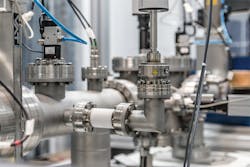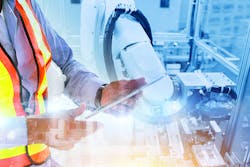Smart temperature measurement
Temperature sensors are heating up — in terms of automation, that is. Here, Mark Howard of automation parts supplier EU Automation, explains how a global network of automation parts supply is bolstering smart temperature measurement and control in today’s manufacturing facilities.
Proper temperature measurement plays a key role in all processing industries. Ensuring temperatures are kept between acceptable parameters through a production line enables high-quality production, control over energy consumption and safe storage of products. However, to reap these rewards the instrumentation and sensors used must be fit for purpose.
Key sensor types
Temperature sensors vary in accuracy and operating temperature range depending on type. Choosing the right sensor depends on the application, longevity, budget, space and accuracy requirements. For most facilities, accuracy is a priority as it leaves less room for error. For processors, fewer errors mean less wasted product and larger profits.
Resistor temperature detector (RTD) sensors are a popular option. The material is usually made from a pure metal and has an accurate resistance-temperature relationship to provide an indication of temperature. RTD sensors are fragile and often housed in protective probes.
As they have higher accuracy and repeatability, RTDs are slowly replacing traditional thermocouples in industrial applications below 600°C. Thermocouples are sensors that produce a temperature-dependent voltage as an indicator of temperature. These devices are an inexpensive and interchangeable option. However, achieving system errors of less than 1 degree Celsius is difficult. In today’s data-driven factories, this limits the ability to process and analyze data correctly.
For greater precision, thermistors are available. This sensor type produces resistance dependent on temperature, to a much greater sensitivity than standard resistors. The temperature indication from a thermistor is precise but can only be achieved within a limited temperature range, typically between -90 to 130°C.
Semiconductor temperature sensors are another option with temperate limitations, operating from -50 to 150°C. These sensors are manufactured in an identical fashion to present-day electronic semiconductor devices like microprocessors, built upon thin silicon wafers. These temperature sensors enable simple interfacing with other electronic devices, including amplifiers, regulators and microcontrollers.
For modern factories, this integration is important. It shows the general trend of temperature measurement technology, and its relation to other equipment in a processing plant. Temperature regulation is more than informing an operator on the temperature of a product. It is also automating a chain of events to correct discrepancies, raise alarms and record such changes.
PLCs are a fundamental part of smart infrastructure.
Digitalization
The four aforementioned sensors have served processing plants well, but as plants take on rapid digitalization, so too do these sensors. Digital temperature sensors are far more advanced than analog alternatives. Instead of providing output in current or voltage form, they give out digital signals. This new breed of temperature sensors is packed with useful features and interfaces to enable visualization of the temperature and its impact on a production line.
As plant managers up their temperature control game, some may be reassessing plant connectivity as a whole. After all, smart temperature monitoring has to be built on solid smart infrastructure. This includes the hierarchy of sensors, Internet of Things (IoT) equipment, programmable logic controllers (PLCs), human machine interfaces (HMI) and supervisory control software.
For example, a thermocouple could be embedded with smart sensors and used in a food storage container. The temperature can be controlled using a PLC, which automatically sends signals to a heating system to adjust the temperature. These changes can be viewed by an operator on an HMI device, whether this is a PC, tablet or mobile phone.
Supervisory control software monitors, processes and records this data in a central network. The operator can control these processes at any time and see the effect on the overall energy consumption of the plant, thus allowing them to make better business decisions.
However, this network of sensors, controllers and devices is only possible with effective supply of industrial parts. After all, if a PLC will not integrate with sensors, the entire smart infrastructure is rendered ineffective.
Temperature data can be accessed from any device.
Take this scenario as an example: A food processing plant has basic temperature monitoring sensors throughout the production line. The facility already has automation software networked for most data points, with a range of sensors and effectors. As part of a considered strategy, the old temperature sensors are replaced with smart sensors that internally process and transmit data.
However, the current temperature control is manual. The operator must turn up the dial on the heater to change the temperature. The facility manager wants to implement automatic adjustment to enable rapid and accurate adjustment of temperature, but this will require the purchase of PLCs or alternative temperature controllers that are compatible with the heating system.
Once the correct brand and model of the PLC is established, sourcing it is the next challenge. This part may be manufactured in another country with limited local stock, or the OEM may have stopped producing the product. Whatever the case, the quicker the part is received, the sooner the facility can benefit from smart temperature monitoring and control.
Global supply networks are crucial to this movement toward digitalized temperature control. Plants can benefit from working with an automation parts supplier with a wide network of distribution centers as well as access to a global network of distributors for the best access to products and stock. Some suppliers can identify exactly where in the world the required part is located from such a network. For the facility manager in need of a specific PLC model, same-day dispatch will ensure the temperature sensor update project can commence quickly and effectively.
Temperature measurement sensors hold huge potential in boosting profits in processing, attributed to less wasted product and improved energy consumption control. However, to deploy them effectively, a facility’s smart infrastructure must run effectively — with a steady supply of industrial parts as necessary.
Mark Howard, EU Automation U.S. country manager, and his multilingual team scour the globe to find quality obsolete, new and reconditioned parts to get industrial machines back up and running.




